Flag of Panama
The flag of Panama was made by María de la Ossa de Amador and was officially adopted by the "ley 48 de 1925".[1] The Panamanian flag day is celebrated on November 4, one day after Panamanian separation from Colombia, and is one of a series of holidays celebrated in November known as the Fiestas Patrias.[2]
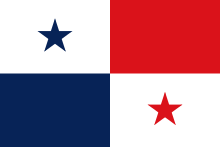 | |
| Name | Bandera de Panamá |
|---|---|
| Use | National flag and ensign |
| Proportion | 2:3 |
| Adopted | March 25, 1925 |
| Design | Divided into four rectangles: going clockwise, each quadrant contains a blue star, a red rectangle, a red star, and a blue rectangle. |
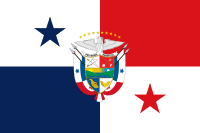 Variant flag of Panama | |
| Use | Presidential standard |
| Design | The national flag with the Coat of arms of Panama charged on the center. |
The first flag proposed in 1903 consisted of thirteen horizontal stripes of alternating red and yellow, with a blue canton containing two golden suns, joined by a narrow line to depict the oceans to be united by the Panama Canal (see the depiction below). However, this was not accepted by the Panamanian leader, Manuel Amador Guerrero, whose family designed a new flag.
The stars and quarters are said to stand for the rival political parties, and the white is said to stand for the peace in which they operate. Blue was the color of the Conservatives and red was the color of the Liberals.[3]
History
Bunau-Varilla proposal
.svg.png)
The wife of Philippe-Jean Bunau-Varilla designed the first serious proposal for a Panamanian flag.[4] Bunau-Varilla's design was based on the flag of the United States, possibly on account of that country's hand in Panamanian independence. Retaining the thirteen stripes, she changed the white stripes to yellow, emphasizing the Panamanian connection to Colombia and Spain (whose flags both prominently feature red and yellow). Bunau-Varilla replaced the stars in the blue canton with two interconnected yellow suns; the suns represent North and South America, and are connected because of Panama's position connecting the two continents.[5] Bunau-Varilla's proposal was rejected by Manuel Amador Guerrero and his fellow revolutionaries because it was too similar to the U.S. flag, and they, therefore, gave the task of designing a flag to Guerrero's son.
María de la Ossa de Amador proposal
The original Panamanian flag was made by María de la Ossa de Amador, the first First Lady of Panama, on November 1, 1903. Manuel Amador Guerrero's son, Manuel Encarnación Amador, generally recognized as a skillful drawer, sketched the flag and showed it to María de la Ossa de Amador, who, after much difficulty in avoiding the Colombian army, eventually produced three copies of the flag, with help from her sister-in-law Angélica Bergamonta de la Ossa and niece, María Emilia de la Ossa Bergamonta. All three flags were flown in Panama City upon independence, and distributed widely. The original flag differs from the present flag in that the upper left quadrant was blue. After independence, when blue was chosen as a color of one of the political parties, the quadrants were shifted to make the top left quadrant white.[6][7]
Description
The Panamanian government officially described the flag in law on December 15, 1949, as follows:
The Flag of the Republic consists thus of a divided rectangle of four quarters: the upper field close to the pole white with a blue star of five points; the upper field further from the pole, red; the lower field near the pole, blue; and the lower one further from the pole, white with a red star of five points.
This flag was to reflect the political situation of the time. The blue was intended to represent the Conservative Party and the red to represent the Liberal Party. The white was intended to stand for peace and purity; the blue star stands for the purity and honesty of the life of the country; the red star represents the authority and law in the country, and together the stars stand for the new republic.
Historical flags
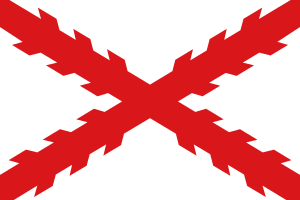

.svg.png)



.svg.png)
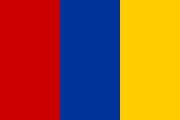





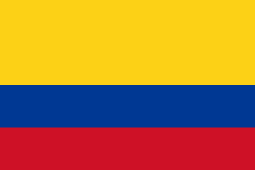

.svg.png)

 Current flag of the Republic of Panama: arose from the modification of the first model and began to be used before the oath of December 20, 1903, and ratified among others by Law 64 of 1904.
Current flag of the Republic of Panama: arose from the modification of the first model and began to be used before the oath of December 20, 1903, and ratified among others by Law 64 of 1904.
Source: [8]
Other flags
 Naval jack of Panama
Naval jack of Panama
See also
References
- Gaceta Oficial No. 4601 Archived March 19, 2012, at the Wayback Machine March 25, 1925
- Chatlani, Manoj (November 7, 2014). "Fiestas Patrias: Panama celebrates its history all through November". POLS - Attorneys. Retrieved November 2, 2018.
- (Flags of the World, published DK Publishing, 1997)
- Schoultz, Lars (1998). Beneath the United States: a history of U.S. policy toward Latin America ([Fourth printing]. ed.). Cambridge, Massachusetts: Harvard University Press. p. 166. ISBN 0-674-92276-X.
- Mellander, Gustavo A. (1971) The United States in Panamanian Politics: The Intriguing Formative Years Danville, Illinois: Interstate Publishers, OCLC 138568
- Guevara, Helkin (November 5, 2015). "Historia de las primeras banderas panameñas y de la que no es 'original'" [History of the first Panamanian flags and of the one that is not 'original']. La Prensa (in Spanish). Panama City, Panama. Archived from the original on November 6, 2015. Retrieved December 23, 2017.
- Pérez, Yelina (November 4, 2016). "Diez datos curiosos de María De La Ossa de Amado" [Ten curious facts about María De La Ossa de Amador]. Revista Mia (in Spanish). Panama City, Panama: La Estrella de Panamá. Archived from the original on November 11, 2016. Retrieved December 21, 2017.
- "Panama - Historical Flags". CRW Flags. February 6, 2007. Retrieved February 1, 2020.
External links
| Wikimedia Commons has media related to Flags of Panama. |